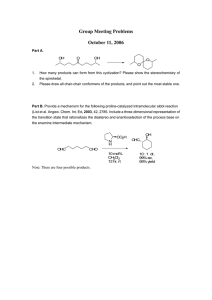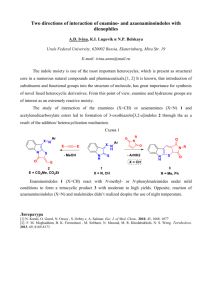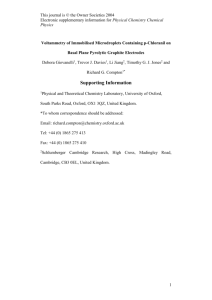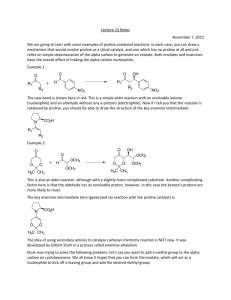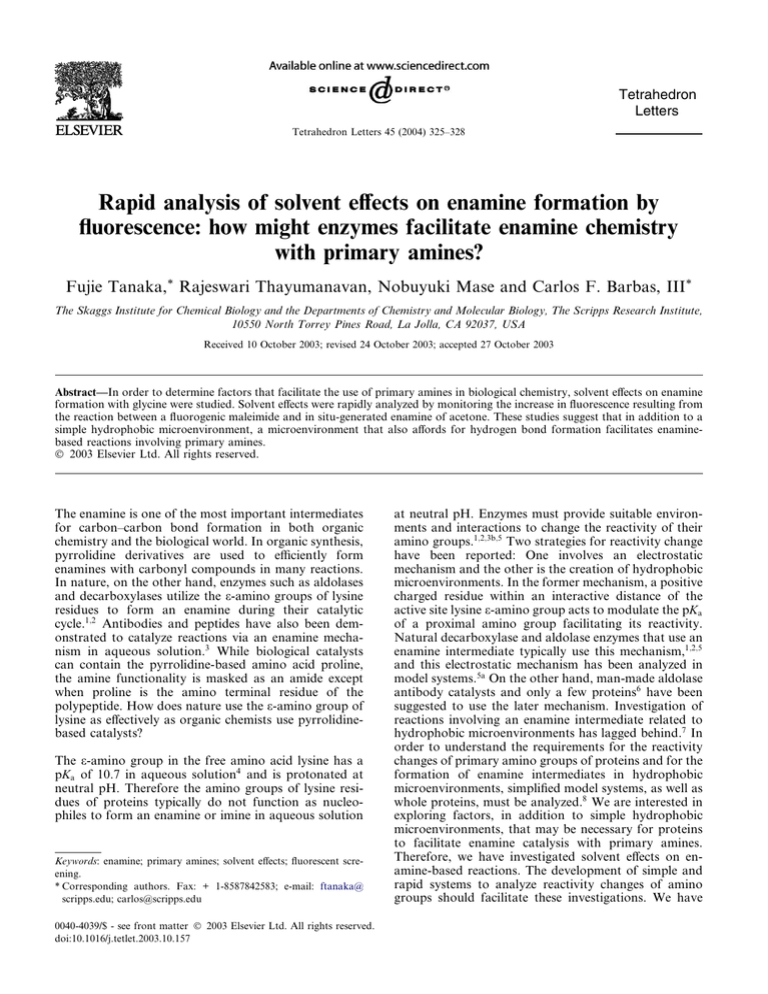
Tetrahedron
Letters
Tetrahedron Letters 45 (2004) 325–328
Rapid analysis of solvent effects on enamine formation by
fluorescence: how might enzymes facilitate enamine chemistry
with primary amines?
Fujie Tanaka,* Rajeswari Thayumanavan, Nobuyuki Mase and Carlos F. Barbas, III*
The Skaggs Institute for Chemical Biology and the Departments of Chemistry and Molecular Biology, The Scripps Research Institute,
10550 North Torrey Pines Road, La Jolla, CA 92037, USA
Received 10 October 2003; revised 24 October 2003; accepted 27 October 2003
Abstract—In order to determine factors that facilitate the use of primary amines in biological chemistry, solvent effects on enamine
formation with glycine were studied. Solvent effects were rapidly analyzed by monitoring the increase in fluorescence resulting from
the reaction between a fluorogenic maleimide and in situ-generated enamine of acetone. These studies suggest that in addition to a
simple hydrophobic microenvironment, a microenvironment that also affords for hydrogen bond formation facilitates enaminebased reactions involving primary amines.
Ó 2003 Elsevier Ltd. All rights reserved.
The enamine is one of the most important intermediates
for carbon–carbon bond formation in both organic
chemistry and the biological world. In organic synthesis,
pyrrolidine derivatives are used to efficiently form
enamines with carbonyl compounds in many reactions.
In nature, on the other hand, enzymes such as aldolases
and decarboxylases utilize the e-amino groups of lysine
residues to form an enamine during their catalytic
cycle.1;2 Antibodies and peptides have also been demonstrated to catalyze reactions via an enamine mechanism in aqueous solution.3 While biological catalysts
can contain the pyrrolidine-based amino acid proline,
the amine functionality is masked as an amide except
when proline is the amino terminal residue of the
polypeptide. How does nature use the e-amino group of
lysine as effectively as organic chemists use pyrrolidinebased catalysts?
The e-amino group in the free amino acid lysine has a
pKa of 10.7 in aqueous solution4 and is protonated at
neutral pH. Therefore the amino groups of lysine residues of proteins typically do not function as nucleophiles to form an enamine or imine in aqueous solution
Keywords: enamine; primary amines; solvent effects; fluorescent screening.
* Corresponding authors. Fax: + 1-8587842583; e-mail: ftanaka@
scripps.edu; carlos@scripps.edu
0040-4039/$ - see front matter Ó 2003 Elsevier Ltd. All rights reserved.
doi:10.1016/j.tetlet.2003.10.157
at neutral pH. Enzymes must provide suitable environments and interactions to change the reactivity of their
amino groups.1;2;3b;5 Two strategies for reactivity change
have been reported: One involves an electrostatic
mechanism and the other is the creation of hydrophobic
microenvironments. In the former mechanism, a positive
charged residue within an interactive distance of the
active site lysine e-amino group acts to modulate the pKa
of a proximal amino group facilitating its reactivity.
Natural decarboxylase and aldolase enzymes that use an
enamine intermediate typically use this mechanism,1;2;5
and this electrostatic mechanism has been analyzed in
model systems.5a On the other hand, man-made aldolase
antibody catalysts and only a few proteins6 have been
suggested to use the later mechanism. Investigation of
reactions involving an enamine intermediate related to
hydrophobic microenvironments has lagged behind.7 In
order to understand the requirements for the reactivity
changes of primary amino groups of proteins and for the
formation of enamine intermediates in hydrophobic
microenvironments, simplified model systems, as well as
whole proteins, must be analyzed.8 We are interested in
exploring factors, in addition to simple hydrophobic
microenvironments, that may be necessary for proteins
to facilitate enamine catalysis with primary amines.
Therefore, we have investigated solvent effects on enamine-based reactions. The development of simple and
rapid systems to analyze reactivity changes of amino
groups should facilitate these investigations. We have
326
F. Tanaka et al. / Tetrahedron Letters 45 (2004) 325–328
applied our fluorescence assay9 (see below) to address
the reactivity of a primary amine in a model system of
an enzymatic reaction and evaluated solvent contributions and characteristics that facilitate this reaction.
Here we study glycine as a model system for protein
catalysts that utilize the e-amino group of lysine residues
to form an enamine during catalysis. Glycine is a good
model system for the following reasons: (1) Glycine has
a single amino group and this feature simplifies analysis.
If lysine were used in these experiments, discrimination
between reactions at the two amino groups of lysine
would be necessary. In enzymes, the lysine residue is
incorporated in the context of the protein and the reactivity of its a-amino group is effectively blocked as an
amide. (2) The pKa of the amino group of glycine is 9.6,4
and like the lysine e-amino group is protonated at
neutral pH. (3) A solution of glycine in H2 O is neutral.
If alkylamines were to be used for these experiments, the
alkaline pH in aqueous medium would be another factor
to be considered.10
We recently developed a fluorescent detection system for
monitoring C–C bond formation by using fluorogenic
maleimide 1 (Scheme 1).9 This substrate reacts with an
in situ-generated enamine of acetone and yields fluorescent product 2. This system is useful for rapid
screening of reaction conditions on a small scale by
monitoring fluorescence. We analyzed a series of solvents for their efficiency in the glycine-catalyzed reaction
of acetone with 1. The relative reaction velocities
observed in the various solvents are shown in Table 1.
Although the rate-limiting step of amine-catalyzed aldol
reactions is typically C–C bond forming step rather than
enamine formation,8c;11 the in situ-generated enamine
intermediate is efficiently trapped by the reactive
maleimide functionality. Thus, comparison of the
velocities of the increase in fluorescence (i.e., comparison of the velocities of the formation of fluorescent
product 2) will indicate an approximate efficiency
ranking of solvents for enamine formation.
As shown in Table 1, reactions in DMSO with 7% and
2% H2 O (entries 4 and 5) were dramatically faster than
the reactions in H2 O (entry 1) or in DMSO with 52%
and 22% H2 O (entries 2 and 3). The reactions in DMF
demonstrated a similar trend with faster velocities
observed in lower concentrations of H2 O: The reactions
in DMF with 22%, 7%, and 2% H2 O (entries 7–9) were
faster than the reaction in H2 O (entry 1) or in DMF with
O
H
N
+
N
O
N
O
1
Catalyst
O
H
N
N
N
2
O
O
Scheme 1. Reaction of fluorogenic maleimide 1 and in situ-generated
enamine of acetone to yield the fluorescent product 2.
Table 1. Relative velocity of glycine-catalyzed reaction of acetone and
1, determined by increase in fluorescencea
a
Entry
Solvent
Relative velocity
1
2
3
4
5
6
7
8
9
10
11
12
79% H2 O
52% H2 O–27% DMSO
22% H2 O–57% DMSO
7% H2 O–72% DMSO
2% H2 O–77% DMSO
52% H2 O–27% DMF
22% H2 O–57% DMF
7% H2 O–72% DMF
2% H2 O–77% DMF
2% H2 O–77% 2-PrOH
2% H2 O–77% MeOH
2% H2 O–77% CH3 CN
<0.5
1
2
40
100
5
30
90
70
50
<0.5
<0.5
Reactions were initiated by adding 1 lL of a stock solution of substrate 1 (5 mM) in CH3 CN to a mixture of acetone (20 lL), 2 lL of
glycine solution (100 mM) in H2 O, and H2 O (77 lL) at 25 °C for entry
1. For entry 2, a mixture of H2 O (50 lL) and DMSO (27 lL) was used
instead of H2 O (77 lL) in entry 1 experiment. The final conditions: [1]
50 lM, [acetone] 20% (v/v) (2.7 M), [glycine] 2 mM in 1% CH3 CN–
79% solvent mixture indicated. The reactions were monitored by the
increase in fluorescence (kex 315 nm, kex 365 nm) for 20 min. The relative velocity was determined by comparison with the velocity of the
reaction at entry 5. Error limits for these measurements were within
±15%. The reaction was heterogeneous in the absence of added H2 O,
so this condition was not studied.
52% H2 O (entry 6). The reaction in 2-PrOH with 2%
H2 O (entry 10) also proceeded. Neither MeOH (entry
11) nor CH3 CN (entry 12) were good solvents for this
reaction.
GlycineÕs amine is located at the a-position relative to
the acid functionality. To analyze whether the distance
between the amine and acid functionalities affects the
reactivity of the amine, reactions with b-alanine were
also analyzed. When b-alanine was used in this reaction
and studied in mixtures of H2 O–DMSO, the relative
velocities were the same as those of the reactions
involving glycine in the corresponding mixtures of H2 O–
DMSO. Thus, the distance between the amine and acid
functionalities did not affect the reactivity of the amine,
suggesting that the solvent effects observed for glycine
should be general for a series of amino acids.
To examine the solvents effect on enamine formation
with glycine more directly, glycines ability to form an
enaminone with 2,4-pentanedione (3) was analyzed in a
series of solvents. The initial velocities for enaminone
formation were determined by the increase in UV
absorption at 318 nm.3a;b The results are shown in Figure 1. Enaminone formation was faster in DMSO,
DMF, and 2-PrOH with a low concentration of H2 O
than in the same solvents with a high concentration of
H2 O.12 Enaminone formation was not observed in H2 O–
CH3 CN or in H2 O–MeOH.12 When b-alanine was
studied as a substitute for glycine in the enaminone
formation reaction in mixtures of H2 O–DMSO, the
reaction velocities were the same as those observed with
glycine.
Overall, the results of the fluorescent studies and the
enaminone studies with respect to the solvent conditions
F. Tanaka et al. / Tetrahedron Letters 45 (2004) 325–328
327
was confirmed by the UV analysis of the enaminone
formation reaction with 2,4-pentanedione (3) and subsequently with the aldol reaction.
Figure 1. Enaminone formation of 2,4-pentanedione (3) with glycine.
Conditions: [3] 1 mM, [glycine] 1 mM in 1% CH3 CN–99% a mixture of
H2 O and cosolvent. The velocities were measured by the increase in
UV absorption at 318 nm. Concentration of the enaminone of 3 with
glycine was corrected by the absorption of the enaminone of 3 with
methylamine. Error limits for these measurements were within ±15%.
O
O
+
H 2N
H
NO2
COOH
DMSO-H2O
(98:2)
r.t. 1 day
O
OH
4 44%
NO2
Scheme 2. Glycine-catalyzed aldol reaction. were in close agreement. These results support the use of
the rapid fluorescent analysis with 1 to investigate conditions for the enamine formation reaction with glycine.
The conditions studied for the enamine formation
reaction were also confirmed by studies of the aldol
reaction. Since enamine formation with glycine was
faster in the conditions determined above, reactions with
electrophiles other than maleimide 1 should also be
faster under similar solvent conditions. When the aldol
reaction of acetone and p-nitrobenzaldehyde was performed in the presence of glycine, the reaction in
DMSO–H2 O (98:2) approximating the condition in
Table 1 at entry 5 provided aldol product 413 (Scheme
2). The same reaction in CH3 CN–H2 O (98:2) approximating the conditions in Table 1 at entry 12 did not
generate detectable amounts of 4 after 1 day. These
results indicate that facilitation of enamine formation
can be key to accelerating reactions involving enamine
intermediates.
We observed significant solvent effects on the reactivity
of the amino group of glycine in reactions designed to
study enamine formation. A rapid fluorescence assay
with fluorogenic maleimide 1 was used to evaluate solvent effects of the reaction of glycine with 1. The data
A mixture of acetone (1.0 mL), p-nitrobenzaldehyde (0.5 mmol), and
glycine (0.15 mmol) in DMSO (3.92 mL)–H2O (80 lL), (net 20%
acetone–1.6% H2O–78.4% DMSO) was stirred at room temperature
for 1day. Workup and purification afforded 4.
DMSO, DMF, and 2-PrOH with a low concentration
of H2 O––that is hydrophobic conditions––facilitated
enamine formation with glycine significantly better than
the same solvents with a high concentration of H2 O.
MeOH, a less hydrophobic solvent than 2-PrOH, was a
poor solvent for the enamine-based reactions. These
results are consistent with natureÕs strategy for the activation of primary amines which involves their placement
in hydrophobic microenvironments within proteins.3b;6
Our results, however, suggest that other factors beyond
simple hydrophobicity are key. Note that DMSO, DMF,
and 2-PrOH are all protophilic solvents and have higher
Kamlet–Taft b values reflecting their solvent hydrogenbond acceptor basicity.14 It may be that the oxygens of
these solvents form hydrogen bonds with protons that
act as acid catalysts for enamine formation and/or stabilize protonated transition states along the reaction
coordinate from imine to enamine formation via hydrogen bond formation. CH3 CN, which does not have
the potential to form hydrogen bonds, was a poor solvent for the enamine-based reaction.14 These results
indicate that enamine formation with glycine is not accelerated simply by reasons that can be attributed to the
solventÕs polarity. Consistent with this is the fact that the
rates of enamine formation with glycine do not correlate
with solvent dielectric constants15 or their Dimroth–
Reichart E(T)N solvent polarity values.16 Thus, hydrophobic conditions together with the capacity to engage in
hydrogen bonds are important factors that facilitate the
reactivity of primary amino groups to form enamines.
Therefore we suggest that in addition to a simple hydrophobic microenvironment, a microenvironment that
also affords for hydrogen bond formation may be necessary for the lysine e-amino group of enzymes to efficiently form enamines.
Acknowledgements
This study was supported in part by the NIH (CA27489)
and The Skaggs Institute for Chemical Biology.
References and Notes
1. (a) Lai, C. Y.; Nakai, N.; Chang, D. Science 1974, 183,
1204; (b) Morris, A. J.; Tolan, D. R. Biochemistry 1994,
33, 12291; (c) Choi, K. H.; Shi, J.; Hopkins, C. E.; Tolan,
D. R.; Allen, K. N. Biochemistry 2001, 40, 13868; (d)
Allard, J.; Grochulski, P.; Sygusch, J. Proc. Natl. Acad.
Sci. U.S.A. 2001, 98, 3679; (e) Heine, A.; DeSantis, G.;
Luz, J. G.; Mitchell, M.; Wong, C.-H.; Wilson, I. A.
Science 2001, 294, 369.
2. Takagi, W.; Gthrie, J. P.; Westheimer, F. H. Biochemistry
1968, 7, 905; Gilbert, H. F., III; OÕLeary, M. H.
Biochemistry 1975, 14, 5194; Gilbert, H. F., III; OÕLeary,
M. H. Biochem. Biophys. Acta 1977, 483, 79; Otwell, H. B.;
Cipollo, K. L.; Dunlap, R. B. Biochem. Biophys. Acta
328
3.
4.
5.
6.
F. Tanaka et al. / Tetrahedron Letters 45 (2004) 325–328
1979, 568, 297; Guidinger, P. F.; Nowak, T. Biochemistry
1991, 30, 8851.
(a) Wagner, J.; Lerner, R. A.; Barbas, C. F., III. Science
1995, 270, 1797; (b) Barbas, C. F., III; Heine, A.; Zhong,
G.; Hoffmann, T.; Gramatikova, S.; Bjornestsdt, R.; List,
B.; Anderson, J.; Stura, E. A.; Wilson, I. A.; Lerner, R. A.
Science 1997, 278, 2085; (c) Hoffmann, T.; Zhong, G.; List,
B.; Shabat, D.; Anderson, J.; Gramatikova, S.; Lerner, R.
A.; Barbas, C. F., III. J. Am. Chem. Soc. 1998, 120, 2768;
(d) Zhong, G.; Lerner, R. A.; Barbas, C. F., III. Angew.
Chem., Int. Ed. 1999, 38, 3738; (e) Karlstrom, A.; Zhong,
G.; Rader, C.; Larsen, N. A.; Heine, A.; Fuller, R.; List,
B.; Tanaka, F.; Wilson, I. A.; Barbas, C. F., III, Lerner, R.
A. Proc. Natl. Acad. Sci. U.S.A. 2000, 97, 3878; (f)
Tanaka, F.; Lerner, R. A.; Barbas, C. F., III. J. Am.
Chem. Soc. 2000, 122, 4835; (g) Shulman, H.; Makarov,
C.; Ogawa, A. K.; Romesberg, F.; Keinan, E. J. Am.
Chem. Soc. 2000, 122, 10743; (h) Johnsson, K.; Allemann,
R. K.; Widmer, H.; Benner, S. A. Nature 1993, 365, 530;
(i) Perez-Paya, E.; Houghton, R. A.; Blondelle, S. E. J.
Biol. Chem. 1996, 271, 4120; (j) Taylor, S. E.; Rutherford,
T. J.; Allemann, R. K. Bioorg. Med. Chem. Lett. 2001, 11,
2631; (k) Tanaka, F.; Barbas, C. F., III. Chem. Commun.
2001, 769; (l) Tanaka, F.; Barbas, C. F., III. J. Am. Chem.
Soc. 2002, 124, 3510.
CRC Handbook of Chemistry and Physics; 83rd ed.; Lide,
D. R., Ed.; CRC: New York, 2002; pp 1–7.
(a) Westheimer, F. H. Tetrahedron 1995, 51, 3; (b)
Highbarger, L. A.; Gerlt, J. A.; Kenyon, G. L. Biochemistry 1996, 35, 41; (c) Blom, N.; Sygusch, J. Nat. Struct.
Biol. 1997, 4, 36.
Dao-pin, S.; Anderson, D. E.; Baase, W. A.; Dahlquist, F. W.; Matthews, B. W. Biochemistry 1991, 30,
11521.
7. Model systems for activity change of amino group in
hydrophobic environment: Liu, L.; Rozenman, M.; Breslow, R. J. Am. Chem. Soc. 2002, 124, 12660.
8. (a) Pollack, R. M.; Ritterstein, S. J. Am. Chem. Soc. 1972,
94, 5064; (b) Bernasconi, C.; Ohlberg, D. A.; Stronach, M.
W. J. Org. Chem. 1991, 56, 3016; (c) Reymond, J.-L.;
Chen, Y. J. Am. Chem. Soc. 1995, 60, 6970.
9. Tanaka, F.; Thayumanavan, R.; Barbas, C. F., III. J. Am.
Chem. Soc. 2003, 125, 8523.
10. Hine, J.; Via, F. A. J. Am. Chem. Soc. 1972, 94, 190; Stefani,
H. A.; Costa, I. M.; Silva, D. O. Synthesis 2000, 1526.
11. Bahmanyar, S.; Houk, K. N. J. Am. Chem. Soc. 2001, 123,
11273.
12. The mixtures in DMF (90% and 98%), in 2-PrOH (40%,
60%, and 80%), in CH3 CN (90% and 98%) were not
homogeneous.
13. This glycine-catalyzed aldol reaction is slower than the
proline-catalyzed reaction under the same conditions. See
also Sakthivel, K.; Notz, W.; Bui, T.; Barbas, C. F., III.
J. Am. Chem. Soc. 2001, 123, 5260.
14. Kamlet–Taft b, hydrogen-bond acceptor basicity values
are as follows: H2 O 0.47, DMSO 0.76, DMF 0.69, 2-PrOH
0.84, MeOH 0.66, CH3 CN 0.40. Reichardt, C. Solvents
and Solvent Effects in Organic Chemistry; 3rd ed. WileyVCH: Weinleim, 2003; p 433.
15. Dielectric constants are following: H2 O 80.1, DMSO 47.2,
DMF 38.3, 2-PrOH 20.2, MeOH 33.0, CH3 CN 36.6. 83rd
Ed. CRC Handbook of Chemistry and Physics; Lide, D. R.,
Ed.; CRC: New York, 2002; pp 8–127.
16. Dimroth–Reichart E(T)N solvent polarity values are as
follows: H2 O 1.00, DMSO 0.444, DMF 0.386, 2-PrOH
0.546, MeOH 0.762, CH3 CN 0.460. Reichardt, C. Solvents
and Solvent Effects in Organic Chemistry, 3rd ed. WileyVCH: Weinleim, 2003; p 418, 471.

